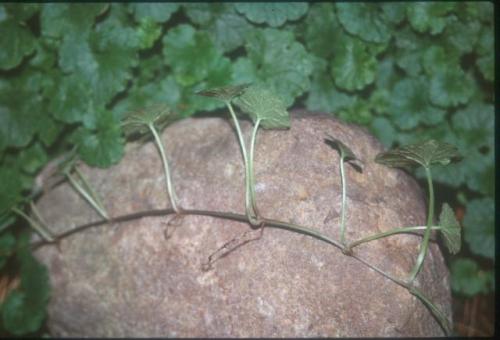
Bulletin E0006TURF
Ground Ivy Control for Home Lawns
DOWNLOAD
May 28, 2015 - Ronald Calhoun
Mention ground ivy or creeping Charlie (Glechoma hederacea) to lawn care professionals or homeowners, and you'll most likely make them wince, scream or both. Ground ivy is a common invader of lawns. In some parts of southeastern Michigan, it is regarded as the most common and most difficult-to-control weed problem in home lawns. Ground ivy is an aggressive, low-growing perennial that favors shaded, moist areas. A member of the mint family, it has square stems and is mildly aromatic, particularly after mowing. If you roll the stem between your fingers, you will feel the ridges of the stem and can get a sense of the square stem phenomenon. This pesky weed has very distinctive coin-shaped leaves with round-toothed edges. This plant is competitive in lawn situations because it creeps along the soil surface and can establish roots at each node (where the leaf attaches to the stem). This feature allows it stick to the ground surface like Velcro and makes hand weeding frustrating, if not impossible. When the soil conditions are just right, however, it is possible to pull up a long string of plants, which brings a smile to the face of most gardeners.
Integrated Management Strategies
As with many turfgrass problems, the long-term approach to managing ground ivy begins with a critical evaluation of the growing conditions for the desirable turf. In most cases, the conditions favorable for ground ivy are not favorable for robust turf growth. Combinations of shade, wet soils and poor fertility stack things against the turf and in favor of the ground ivy. Correcting these conditions will allow the turf to compete better with the ground ivy. In addition, make sure your mowing height is at least 2.5 inches and preferably 3 inches or above - this will give the turf a competitive edge.

The aboveground runners (stolons) allow ground ivy to quickly fill in voids in the turf.
Removal: Spring and Fall
Hand weeding is certainly an option for removing ground ivy, but it is usually a tedious task because of the many roots along the stem. Most often the will of the ground ivy to invade outlasts the will of the gardener to weed. Chemical strategies are also effective if the timing of application is correct. In general, fall is the best time to apply postemergence herbicides for broadleaf weed control. Fall is, in fact, an excellent time to treat ground ivy. However, in a compelling study, Dr. Frank Rossi examined several herbicide products and timings and identified another effective time for ground ivy control. Herbicide treatments were effective not only in the fall but also in the spring when the ground ivy was in flower. Ground ivy has small, bluish purple, funnel-shaped flowers that usually appear in May. Using 2,4-D alone provided adequate control when applied at each of these timings. Combination products of 2,4-D, dicamba and MCPP/MCPA provided better control than 2,4-D alone.
Removal: Summer
All the products in these studies provided less effective control when applied during the summer. Plants are often more difficult to control in the summer because of slow uptake and metabolism associated with high temperatures. Late spring and summer control options do exist, but the products are currently limited to professional lawn services. Studies at MSU have shown that certain combinations of broadleaf herbicides with quinclorac (Drive) are effective against ground ivy during the summer. Quinclorac is primarily a postemergence crabgrass herbicide that also has good activity on clover and knotweed. Results from the past several years indicate that the broadleaf weed control (ground ivy, speedwell and violets) of several broadleaf herbicides can be dramatically increased by tank mixing them with quinclorac. Products containing 2,4-D have benefited the most from this combination. These combinations deserve consideration for mid-to late summer weed control applications.
Herbicide Conclusions
Products containing triclopyr (Confront, Chaser, Battleship, Momentum, Weed-B-Gon purple label) have proven to be highly effective in spring and fall and more effective than 2,4-D-based products during the difficult summer period. Triclopyr is available to homeowners and has activity on weeds that are traditionally labeled hard-to-control (i.e. 2,4-D didn't work). For this reason, triclopyr is probably the first alternative to try when a 2,4-D mixture has failed to provide acceptable control. Because of their complementary activity, combinations of triclopyr + 2,4-D can be very effective.
Alternative Approach?
Researchers at Iowa State University reported control of ground ivy using 20-Mule Team Borax. That's right - the laundry product on the shelf at your favorite market that has been around since the frontier days. Dr. Rossi also used this treatment in the Wisconsin study. The rates were 20 or 30 ounces mixed in 1 gallon of water. ISU researchers concluded that the ground ivy was sensitive to the boron in the Borax and was injured to the point of dysfunction. The treatment was not effective in Dr. Rossi's trial, and he concluded that Wisconsin soil conditions likely tied up the boron before it had any effect on the ground ivy. This treatment is untested in Michigan. If you try it, please let us know the results.
Take-home Message
Ground ivy control from herbicide applications will be temporary, at best, unless the growing conditions that initially encouraged the infestation are improved. Combining good maintenance practices with judicious herbicide use is the best strategy to combat ground ivy in the lawn. Always read, understand and follow the directions on the herbicide label.



 Print
Print Email
Email




